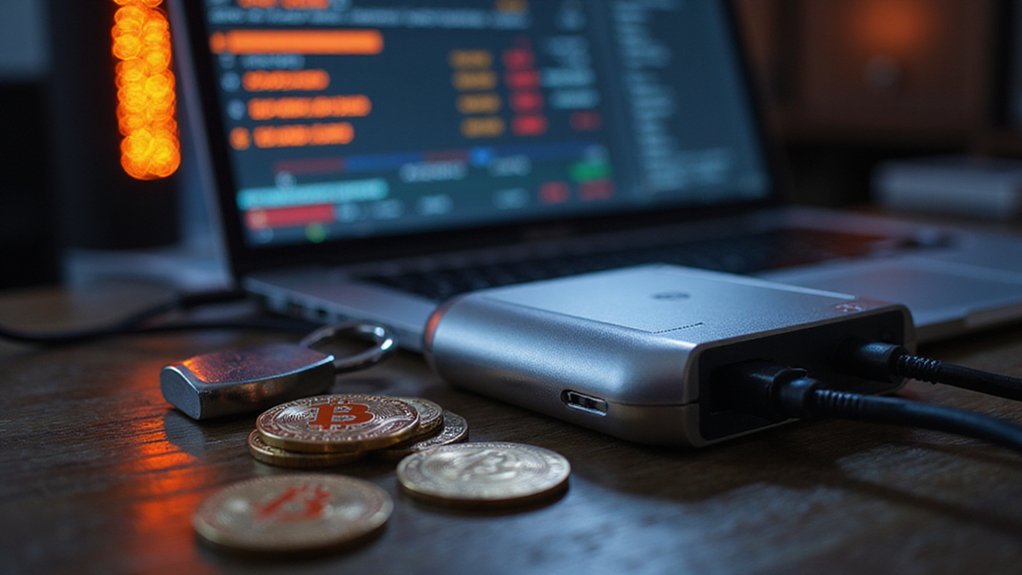Cryptocurrency regulation presents a fundamental paradox: governments attempt to impose traditional oversight on assets designed to circumvent such control. The United States witnesses bureaucratic turf wars between the SEC and CFTC over asset classification, while Singapore and Hong Kong position themselves as digital hubs through licensing regimes. The EU’s thorough MiCAR framework contrasts sharply with America’s historical “regulation by enforcement” approach, creating a patchwork of global standards that leaves market participants maneuvering Byzantine compliance landscapes—though emerging clarity promises to illuminate these murky waters.

How does one regulate something that was explicitly designed to circumvent traditional regulatory oversight?
This fundamental paradox underlies the evolving global cryptocurrency regulatory landscape, where governments attempt to impose traditional frameworks on inherently decentralized digital assets.
The regulatory approaches vary dramatically across jurisdictions, ranging from light-touch frameworks to strict oversight regimes.
While the United States grapples with its characteristic bureaucratic turf wars—the SEC and CFTC engaging in jurisdictional disputes over whether cryptocurrencies constitute securities or commodities—other regions have adopted more coherent strategies.
Singapore and Hong Kong are positioning themselves as digital asset hubs through thorough licensing regimes and targeted stablecoin regulations, demonstrating that regulatory clarity need not stifle innovation.
The classification conundrum remains particularly vexing.
Determining whether a digital asset qualifies as a commodity or security fundamentally shapes regulatory jurisdiction and compliance obligations.
Different countries have developed disparate classification systems, creating a patchwork of global standards that would challenge even the most sophisticated multinational crypto operation.
The overlapping regulatory responsibilities across agencies compound these complexities, leaving market participants maneuvering an increasingly Byzantine compliance landscape.
Perhaps most significantly, the United States appears to be abandoning its infamous “regulation by enforcement” approach—a strategy that resembled shooting first and asking questions later—in favor of crafting clearer rules for digital assets.
This shift represents a tacit acknowledgment that retroactive clarity serves neither innovation nor investor protection. The new approach includes establishing interdepartmental working groups to develop comprehensive regulatory and legislative proposals within structured timeframes.
Meanwhile, the European Union’s Markets in Crypto-Assets Regulation (MiCAR) attempts to provide thorough oversight, though its interim period creates the delicious irony of regulatory uncertainty within a framework designed to eliminate uncertainty.
The EU’s approach to stablecoin regulations reflects particular concern about financial stability, recognizing that algorithmic monetary policy might occasionally prove less reliable than traditional central banking.
Asia-Pacific regions are developing what they term “rigorous yet balanced” regulatory frameworks—diplomatic language for trying to capture innovation benefits while avoiding the next spectacular crypto meltdown.
The emergence of security tokens as blockchain-based financial instruments has added another layer of complexity, as these digital securities must comply with traditional securities laws while leveraging the enhanced transparency and efficiency of distributed ledgers.
The IRS treats digital assets as property subject to capital gains taxes, creating additional compliance considerations for cryptocurrency holders who must track transactions for tax reporting purposes.
The consensus emerging globally suggests that regulatory certainty, rather than regulatory absence, will ultimately drive sustainable sector growth and institutional adoption.
Frequently Asked Questions
What Happens to My Cryptocurrency if the Exchange I Use Gets Shut Down?
When exchanges collapse, investors typically face an unpleasant reality: accessing funds becomes problematic, if not impossible.
While some platforms attempt orderly withdrawals before closure, many users find themselves trapped in lengthy, uncertain fund distribution processes.
The fortunate few who diversified across multiple exchanges or maintained cold storage avoid this predicament entirely.
Legal proceedings may eventually recover partial assets, though such outcomes remain disappointingly unpredictable.
Can I Deduct Cryptocurrency Trading Losses on My Tax Returns?
Yes, cryptocurrency trading losses are deductible when realized through actual sales or disposals.
The IRS treats crypto as property, allowing losses to offset capital gains from any source, plus up to $3,000 annually against ordinary income.
Excess losses carry forward indefinitely.
However, losses from hacking, lost keys, or exchange collapses¹ generally aren’t deductible—because apparently the tax code distinguishes between voluntary poor timing and involuntary digital misfortune.
—
¹ As previously discussed regarding exchange shutdowns, though bankruptcy scenarios may occasionally qualify.
How Do I Report Cryptocurrency Gifts or Inheritance to Tax Authorities?
Taxpayers must report cryptocurrency gifts and inheritance on federal returns using Forms 8949 and Schedule D, with estates requiring Form 1041.
Recipients record fair market value at transfer date—inheritance receives stepped-up basis (reducing capital gains), while gifts retain donor’s original basis.
Given cryptocurrency’s volatility, precise valuation documentation proves essential.
The IRS’s digital asset question appears across all major tax forms, making omission rather conspicuous for those hoping to avoid reporting obligations.
Are Cryptocurrency Mining Rewards Considered Taxable Income in All Countries?
Cryptocurrency mining rewards face decidedly uneven tax treatment globally—while most jurisdictions (including the US, UK, and Australia) classify them as taxable income, notable exceptions exist.
Singapore imposes no capital gains tax, Germany exempts holdings over one year, and UAE free zones offer zero-percent rates.
This patchwork approach creates interesting arbitrage opportunities for those willing to relocate their mining operations to more favorable tax climates.
What Legal Protections Exist if I’m Scammed in a Cryptocurrency Transaction?
Cryptocurrency scam victims possess several legal remedies, though recovering funds remains challenging given blockchain’s immutable nature.
The Internet Crime Complaint Center (IC3) accepts reports, while the FTC investigates false claims about cryptocurrency services.
Civil litigation against perpetrators offers another avenue, requiring specialized cryptocurrency attorneys who understand emerging legal precedents.
Regulatory bodies collaborate using blockchain analytics to trace fraudulent transactions, though success rates vary considerably depending on the sophistication of the scam.









